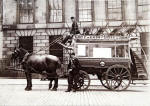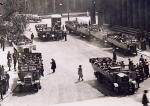|
Edinburgh Transport Buses Please click one of the links below OR scroll down this page. |
|
1. Edinburgh - Steam Transport |
Edinburgh Steam Transport |
|
There were early experiments with a steam driven carriages on Queensferry Road, for a few months in 1827. Steam-powered road transport was also used in the early 1870s, on routes between: - Edinburgh West End and Leith (a light traction engine pulling a passenger-carrying trailer) - Edinburgh and Portobello (a steam-powered bus ran for 4 months until it caught fire). However, the road surfaces were not good, and most passengers remained loyal to the horse-drawn vehicles. |
|
Reference: Edinburgh Transport [DGL Hunter] |
|
Edinburgh Horse-drawn Buses |
|
Earlier in the century, most horse drawn road transport carried only two of four passengers, However, by 1869, Edinburgh had horse-drawn buses operating several routes. The buses were painted in different colours, and displayed different coloured lights at night to indicate the route they operated on. Horse-drawn buses (as well as horse drawn trams) continued throughout the century. Photographs of Waverley in the 1890s often show several of the buses standing in Princes Street at the top of Waverley Steps (that lead from Waverley Railway Station). |
|
Reference: Edinburgh Transport [DGL Hunter] |
|
Edinburgh Motor Buses |
| In the early 20th century, the main means of public transport in Edinburgh's streets was the cable tramway system, followed by the electric tramway system - but there were also a few buses. |
|
Early Operators The first motor-bus service, from the Post Office to Haymarket, was introduced as early as 1898. This used a fleet of Daimler cars with wagonette bodies. John Love operated Edinburgh's first motor bus service in 1898, running from the Post Office to Haymarket. Around 1901, he added a route from Haymarket to Salisbury Place. By 1906, Edinburgh Autocar Company was operating a route in Portobello. |
|
SMT In 1905, the Scottish Motor Traction Company was established. In 1906, its buses ran to Cramond and the Forth Rail Bridge at South Queensferry. By 1910, the company had 20 motor buses. Rather than compete with Edinburgh's tramways, the company operated services to towns outside Edinburgh. By 1919 it had routes to Bangour, Gorebridge, Penicuik, Rosewell, South Queensferry and Winchburgh. From 1936, SMT moved their bus stances from Waverley Bridge to St Andrew Square. |
|
Edinburgh & District Motor Company Ltd In 1914, Edinburgh & District Motor Company Ltd acquired 3 charabancs. In 1916 the company operated tours to the Forth Bridge at South Queensferry. |
|
Edinburgh Corporation Transport Department In July 1919, responsibility for Edinburgh's tramways passed to the Tramways Dept of the City. The city immediately set about converting the cable tramway system to an electric system. In 1919, three charabancs arrived and ran a circular service around the City, departing from the Foot of the Mound
In 1922, the Corporation purchased its first double-deck bus. In 1935, the first covered-top double-deck buses appeared on Edinburgh's streets. New bus services were introduced in the late 1940s, as new housing was built around Edinburgh. Throughout the early 1950s, individual tram services were converted to bus operation, the final tram running on 16 November 1956. |
|
Reference: Edinburgh Transport - The Early Years [DGL Hunter] Edinburgh Transport - The Corporation Years [DGL Hunter] |
|
TRANSPORT |
|||||||
| Full Index |
Bus Tickets |
Railway Tickets |
|||||

